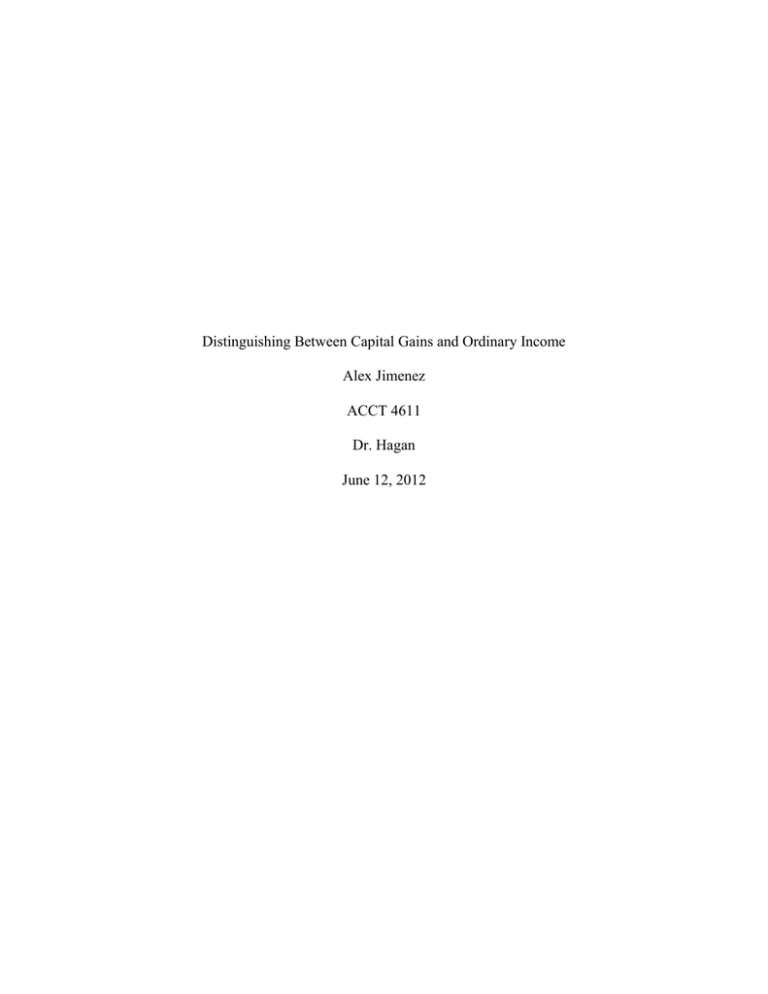Distinguishing Between Capital Gains and Ordinary Income
advertisement

Distinguishing Between Capital Gains and Ordinary Income Alex Jimenez ACCT 4611 Dr. Hagan June 12, 2012 Jimenez 1 Table of Contents Introduction .............................................................................................................................................................. 2 Capital Gains Rules and Benefits ....................................................................................................................... 3 Trantina vs. United States: Introduction .......................................................................................................... 3 Trantina vs. United States: The Original Case ............................................................................................... 5 Trantina vs. United States: Appellate Court ................................................................................................... 5 Conclusion ................................................................................................................................................................ 7 Works Cited .............................................................................................................................................................. 9 Introduction Capital gains taxes are a very large section of the Internal Revenue Code and the code that lays out the rules for capital gains and losses can be very complicated and difficult to understand. Firms or individuals will frequently try and manipulate ordinary income into capital gain. The reason is because capital gains are eligible for preferential treatment while losses are limited to certain deduction restrictions. The issues will often arise from distinguishing between whether income is a capital asset or a normal operating asset. Additional issues also include how the income generated was derived and the timing of the recognition of the revenues because of the impact on current or future year returns. It is important to have an understanding of how and what are capital gains so that a taxpayer is knowledgeable enough to take advantage of the capital gain preferences within the spirit of the law. In order for income to be considered a capital gain it must meet two guidelines outlined by the IRC they are an asset must be a capital asset and a sale or exchange must have taken place.1 Often times taxpayers and the Internal Revenue Service will disagree on whether an asset is considered capital or ordinary as well as whether or not income generated is eligible for the capital gains preferential tax rates. When these disagreements occur they are sometimes taken to either tax court or general district court where the judicial system can make their official ruling on the issue. One example of when this has happened is a case involving an insurance agent that is retiring and whether the money he received for all of his agency assets is considered capital gains or ordinary income. In this particular case two courts heard similar cases and issued agreeing opinions. However, this is not always the case and if the Supreme Court feels there is a definite need for clarification they will hear the case. 1 26 U.S.C. § 1221(a) Capital Gains Rules and Benefits Before looking deeper into cases that have been taken to court it is important to have a better understanding of what a capital asset is. The code defines “capital asset” as any “property held by the taxpayer (whether or not connected with his trade or business)” excluding eight categories of property not relevant in this case.2 The code defines those assets as normal business operation assets, certain U.S. publications, copyrights etc., and business transactions. It should also be noted that most assets do not fall under the category of capital assets. The conditions of a capital gain or loss are noted above, and if these conditions are not met no capital gain can be recognized. Another advantage of capital gains and losses is a taxpaying person is allowed to offset any capital gain with any capital losses that have incurred within the same taxable year.3 Individuals and corporations are subject to fairly similar provisions regarding capital gain and loss recognition. Individuals are allowed to offset gains with losses and record a net loss up to $3,000.4 Corporations are not allowed to report any net capital loss, but they are able to carryback any net loss 3 years or forward 5.5 While individuals are only able to carry their losses forward, however, they are allowed to do this indefinitely into future taxable years.6 Trantina vs. United States: Introduction The issue that will be argued in the court case discussed will not involve any disagreements about recognition or net operation losses, but will strictly focus on whether an asset is capital or ordinary and whether a transaction took place. The case involves a man named Charles Trantina v. United States. Mr. Trantina operated his own State Farm insurance agency as 2 26 U.S.C. § 1221(a) IRC §§ 1211, 1212 4 IRC §§ 1211, 1212 5 IRC § 1212 6 IRC § 1211 (b) 3 a sole proprietorship starting in 1958 and decided to incorporate his agency under the name of Trantina Insurance Agency, Inc. in 1978. Upon incorporation State Farm Insurance Companies issued the newly formed incorporation a Corporation Agency Agreement. The agreement is what becomes the center of the case, because it is disputed whether or not the agreement is a capital asset or a normal business asset. The Corporation Agreement stipulated that the Corporation was required to exclusively sell State Farm policies and all manuals, forms, and documents provided to the Corporation remained property of State Farm. Additionally, all policy information including names, addresses, age, renewal and expiration dates and location of insured property were all trade secrets of State Farm. In return the Corporation would be compensated for the policies sold, State Farm would also help with advertising costs, and that the Corporation was entitled to monthly termination payments that were payable monthly for five years. The termination payments were subject to two conditions, “the first one being that the Corporation was required to return to State Farm, within ten days of termination, all of State Farm’s property, including forms, manuals, and other documents concerning policy information and policy holders.” The second condition stated, “The Corporation, its president, and its licensed sales representatives—three positions all held by Trawere required to comply with a non-compete agreement that prevented Trantina, for a period of twelve months, from selling insurance competitive with State Farm's products to any of the customers whose policies he had serviced.” Mr. Trantina notified State Farm that he would terminate on June 30, 1996 and he complied with both conditions of the agreement making him eligible for the termination payments. The Corporation received the payments until its dissolution in March of 1997 and Mr. Trantina received the payments afterwards. Trantina vs. United States: The Original Case In 1999 Mr. Trantina and his wife filed a joint return classifying the income from the termination payments as ordinary income. However, on April 10, 2003 they filed an amendment to their 1999 tax return seeking to reclassify the termination payment as a capital gain and reduce their tax liability for 1999. The Trantinas wanted a refund of $15,982 plus interest. The IRS denied their refund on June 30, and the Trantinas filed suit in Arizona on December 24. The Trantinas made two claims as to why their refund should be granted. The first reason being, “they claimed that the termination payments were long term capital gain because the payments, originally an asset of the Corporation, were made to Trantina after he exchanged his shares in the Corporation for the assets of the Corporation during the liquidation.” The second claim stated, “the Trantinas claimed that the payments are long term capital gains resulting from the sale or exchange of a capital asset-the Corporate Agreement itself-held longer than one year.” The court found since the Trantina’s failed to report their first claim to the I.R.S. the court had no jurisdiction to hear the claim, and it was subsequently thrown out. The second claim the court found that the agreement was not a capital asset, and they also reasoned that if it was no sale or exchange occurred.7 Trantina vs. United States: Appellate Court The Trantinas did not give up and took their case to appeal, but this time they dropped the first claim and only argued the second. The statute establishes three requirements that must be met to classify income as a long term capital gain: The payments (1) must arise from the sale or exchange, (2) of a capital asset held longer than one year, (3) and be given in consideration of 7 Trantina v. United States 1105-06 (9th Circuit) this sale or exchange.8 The Trantinas argue that these requirements are satisfied because the agreement itself is a capital asset and that it is exchanged for the termination payments. The United States insisted they did not stipulate a capital gain because the Corporation held no rights to the property under the agreement except the obligation to perform services and be compensated for them. Furthermore, the government challenges that no sale or exchange occurred and it was brought to an end on its own terms. The Appellate court agreed with the government and ruled the Corporate Agreement was not a capital asset. The code defines “capital asset” as any “property held by the taxpayer (whether or not connected with his trade or business)” excluding eight categories of property not relevant in this case.9 A very literal translation of this definition could result in every possible property interest, including employment contracts to be considered capital gains upon termination.10 This issue has caused the Supreme Court to issue the opinion that “not everything which can be called property in the ordinary sense and which is outside the statutory exclusions qualifies as a capital asset.”11 Accordingly, the courts interpreted that capital assets should be defined narrowly and it is determined by the nature of the property right the holder asserts over the property. The seventh court faced a similar trial involving a man named Mr. Baker who was in a fairly similar situation as the Trantinas. Mr. Baker instead used a different reasoning claiming his payments were a result of the goodwill he acquired through his thirty-four year career.12 The 8 Baker, 338 F.3d at 793 26 U.S.C. § 1221(a) 10 United States v. Maginnis, 356 F.3d 1179, 1181 (9th Cir.2004); Furrer v. Comm'r, 566 F.2d 1115, 1117 (9th Cir.1977) (per curiam) (“If all contracts granting rights could be considered capital assets, without inquiry into the nature of the rights granted, almost all ordinary income from salaries, wages or commissions could be transformed into capital gain.”) 11 Comm'r v. Gillette Motor Transp., Inc., 364 U.S. 130, 134, 80 S.Ct. 1497, 4 L.Ed.2d 1617 (1960) 12 Baker v. Commissioner 338 F.3d 789 9 court found that no sale or exchange had occurred and therefore the income was to be taxed at ordinary rates. The ninth court adopted this ruling from the seventh court. In Mr. Trantina’s case the court stated a precondition to realizing a capital gain is the ownership of a capital asset. Mr. Trantina, under the Corporation Agreement, had no property that he could sell or exchange. The court ruling contained almost identical wording as Mr. Baker’s ruling that he had no property that he could sell or exchange. Their examination led them to conclude it was unclear what Mr. Trantina owned and that he could not sell something back to State Farm something it had already owned. Mr. Trantina attempted to distinguish himself from Mr. Baker, but the seventh court struck down not only his goodwill argument but also his claim to have held a capital asset. In conclusion the appellate court was unable to determine any property rights for the Trantinas, and was unable to find any cause to classify the agreement as a capital asset. Therefore, the appellate court ruled affirmed the district court ruling for the United States.13 Mr. Trantina tried to get the court to agree with his plea for capital gains treatment, but in the end the courts made a very valid argument with he can not sell something back he does not own. This is just one example of many where the IRS and a taxpayer disagree over what is considered a capital asset or not and whether a sale or exchange had occurred. Conclusion The case examined she light on the reality that the Internal Revenue Code can be very difficult to understand and is written to where an individual taxpayer is left with some discretion in how they classify assets. Whether an asset is capital or ordinary can have a large impact on an individuals tax liability, and it is the job of the IRS to ensure that everyone is properly recording 13 Trantina v. United States 1105-06 (9th Circuit) capital gains and ordinary income. The code dealing with capital gains has become a very important part of how corporations and individuals alike deal with their financial situations. The case of Mr. Trantina gave insight into what the substance of a capital asset is and how difficult it can be to assign the proper treatment to that asset. The case also went into depth on whether a sale or exchange had occurred between the two parties. These two requirements of capital gain are extremely important to understand for making proper decisions regarding personal or corporate tax law. Works Cited "Banking, Financial Services; Careful Year-End Handling of Individuals Capital Gains and Losses can Save Taxes." Investment Weekly News (2010): 496. ABI/INFORM Complete. Web. 11 June 2012. Edrey, Yoseph M. "What are Capital Gains and Losses Anyway?" Virginia Tax Review 24.1 (2004): 141-86. ABI/INFORM Complete.Web. 23 May 2012. Trantina v. United States. United States Court of Appeals, Ninth Circuit. 2008. FindLaw. Web. 23 May 2012.






